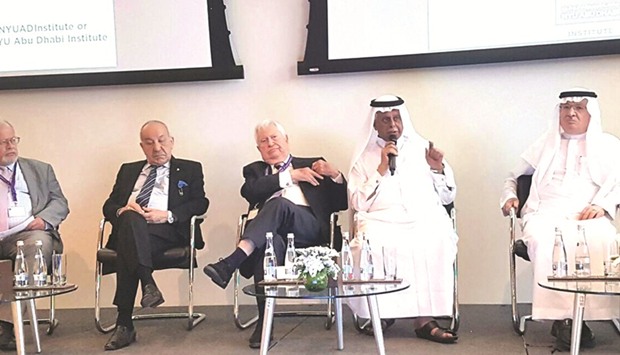Shale oil is “a form of non-Opec competition just as any other non-Opec oil producer is”, said HE Abdullah bin Hamad al-Attiyah, former Deputy Prime Minister and Minister of Energy and Industry.
On a global liquids supply level of around 95mn barrels a day, shale (tight crude and unconventional NGL) represents around 7%, al-Attiyah said at the ‘Abu Dhabi Roundtable’ hosted by New York University (NYU) Abu Dhabi Institute in collaboration with the University of Oslo.
The chairman of Abdullah Bin Hamad Al-Attiyah International Foundation for Energy and Sustainable Development noted this share would increase and expected to reach 9% in the long run.
“But in absolute terms it is substantial as it will evolve from the current 6.5mn barrels per day to nearly 9mn bpd by 2025 and potentially 10mn bpd in 2030, only to decline later,” he said. “What matters is the breakeven price of this new supply and how the shale producers can value their product and make it available to the market. And it is at this level where strategies of different market players will be defined.
“What is even more important is not shale itself but the driving force behind it, which is technology. Thus, we have to be very careful in future (near and far) on how technology will evolve and bring down the cost of shale and its corresponding breakeven price,” al-Attiyah emphasised.
On the durability of the current Opec cooperation with some non-member countries, he said, “The current cooperation can stand as long as the compliance to the cuts will be satisfactory. This will depend on how the market will react, if the implied glut will be resorbed, and if the cooperation will not lead to the worst situation, where other non-Opec producers might profit from this setting to increase their market share and undermine the Opec/non-Opec deal.
“In the past, the compliance was not always perfect from both sides, this is why it is very important to keep the current momentum with actually remarkable levels of conformity to the commitments, with 86% compliance level in January and 94% in February this year, of the agreed total cut of Opec and non-Opec countries of about 1.8mn bpd (1.2mn bpd for Opec and 0.6mn bpd for non-Opec).”
Asked how the shift in emphasis from “peak oil” to “peak demand” change the strategy of Opec countries, al-Attiyah said, “Who can tell what the demand – supply balances will be? However, it is starting to look as if there will not be neither ‘peak oil’ or ‘peak demand’.”
He said, “So far, the reference cases – either of the IEA or Opec do not show any peak demand, rising currently from around 95mn bpd to a range between 110 to 120mn bpd by 2040.
It is only in extreme scenarios related to an aggressive penetration of renewables into the world energy mix that this demand could really peak before 2040. As the environmental issues get more and more importance and the consensus towards the Paris agreement gets more momentum, it is likely that a more sluggish growth of the global oil demand could be experienced in the future.
“The main driver that can lead to this kind of peak demand is a revolution in the road transportation sector, which represents nearly 45% of overall oil demand, where a bigger penetration of electric vehicles can be the real threat and undermine the growth of global oil demand.”

HE al-Attiyah (second right) at a panel session at the ‘Abu Dhabi Roundtable’ hosted by New York University Abu Dhabi Institute in collaboration with the University of Oslo.
